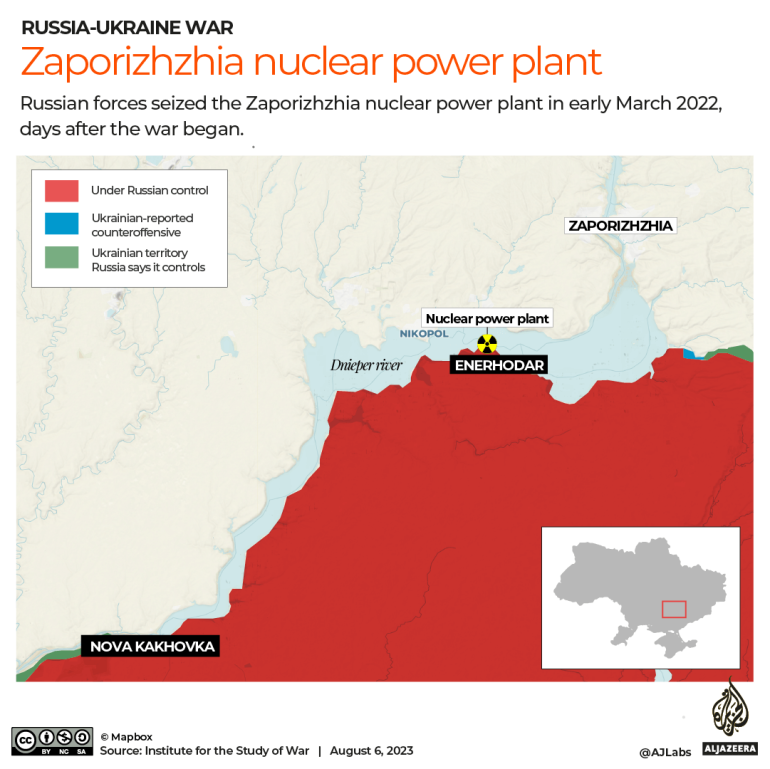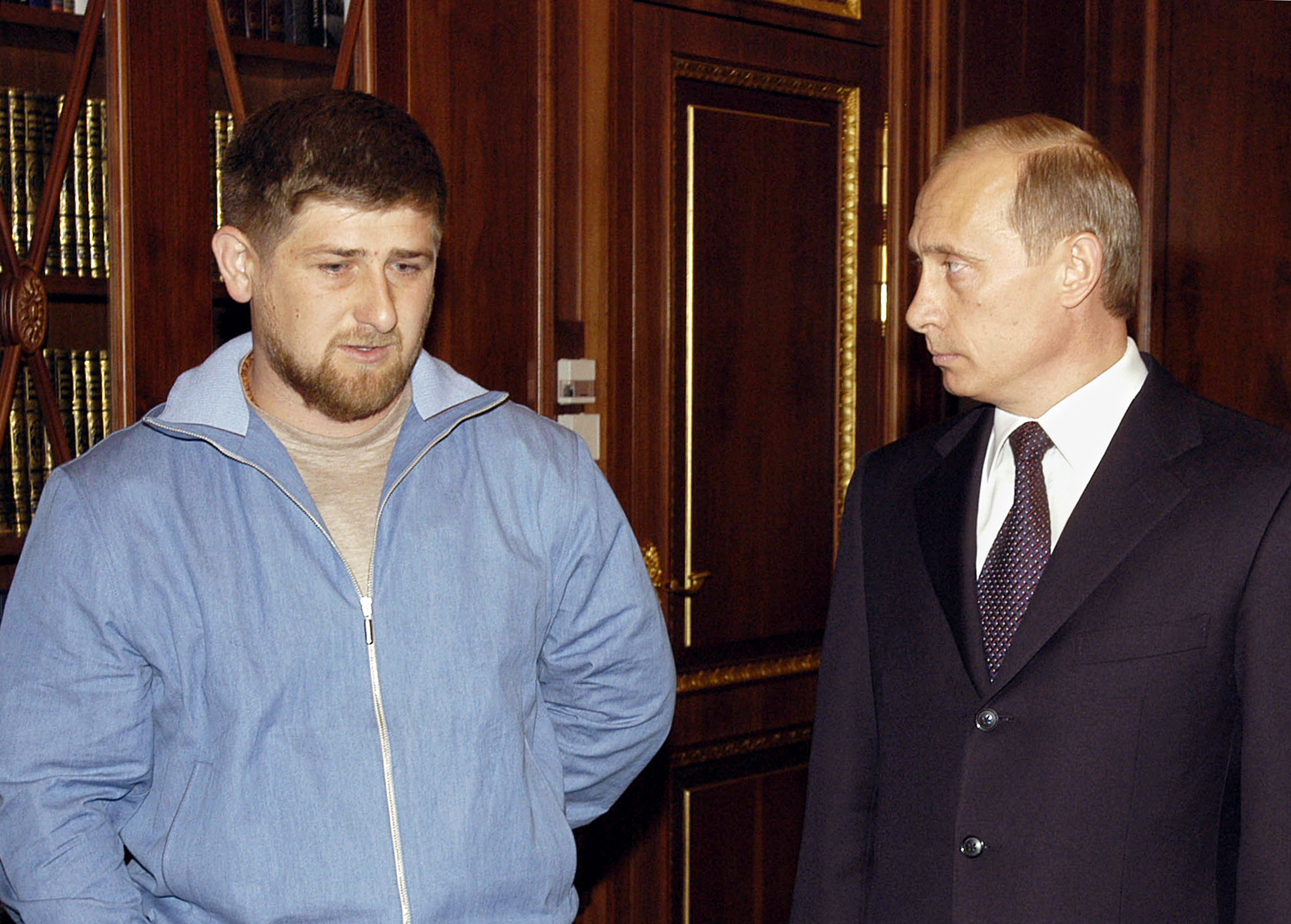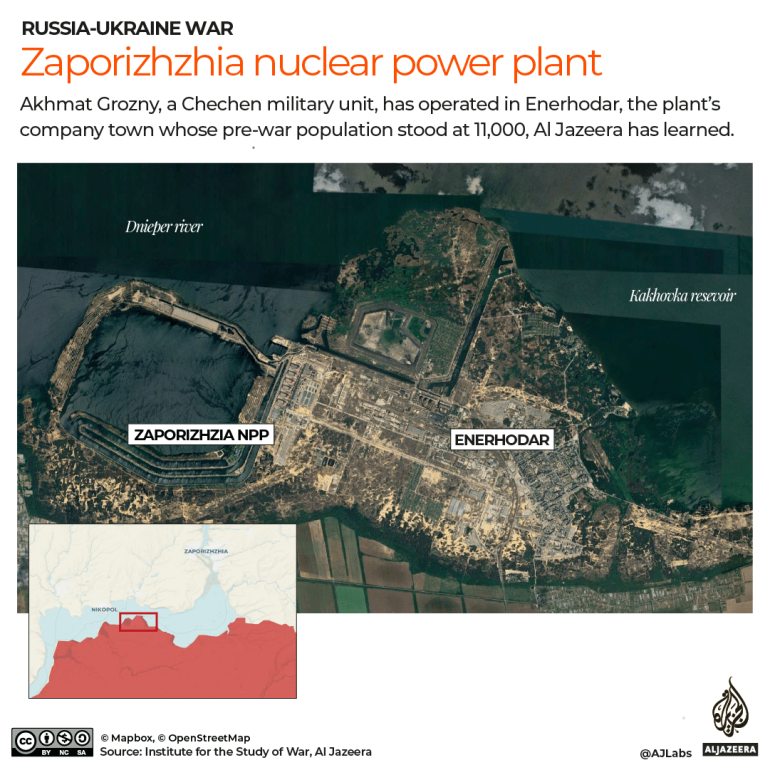
All nine pumped-up men in the video sport beards, beanie hats, and khaki uniforms with no name tags.
One has a walkie-talkie, another, a gun, and behind them are jeeps and silver minibuses. Most of the men are about to leave. One wants to be photographed.
“Take a picture instead of filming,” he tells the invisible cameraman in Chechen.
The camera turns to another man who is checking his smartphone. The cameraman says, “This comrade is staying.”
The man with the phone looks like he’s in charge. He winks, smiles and responds: “I’ll be leaving later.”
They look relaxed as if they are back in Chechnya, the predominantly Muslim province of 1.5 million in Russia’s North Caucasus region, where Ramzan Kadyrov, a former separatist strongman who now calls himself Russian President Vladimir Putin’s “soldier”, is their boss.
The men were, however, filmed some 1,200km northwest from home, next to blocks 3,4 and 5 of the Zaporizhzhia nuclear power plant – Europe’s largest nuclear facility – in the Russia-occupied part of southeastern Ukraine.
The video was made available to Al Jazeera by a Ukrainian law enforcement agency, which identified the man with the phone as Colonel Makhmud Khusiyev, a 43-year-old former wrestler.
The footage is dated January 7, but was possibly filmed earlier.
The agency verified his identity by using face-recognition software to compare his high-resolution photos and videos with media reports that feature him.
Khusiyev keeps a low profile.
A handful of Chechen news articles mention his participation in wrestling competitions.
Khusiyev is now one of several senior officers of the Akhmat Grozny, a special forces company based in Grozny, Chechnya’s administrative capital.
In the video obtained and verified by Al Jazeera, the left shoulder of Khusiyev’s uniform is adorned with the stylised image of an eagle shooting rays out of his eyes – one of the company’s logos.
Al Jazeera also confirmed his identity, having found now-deleted dating profiles that appeared to belong to him, featuring old photos of him donning the uniform of Chechen riot police.
Akhmat Grozny operates in Enerhodar, the plant’s company town whose pre-war population stood at 51,000, and has more than halved since then.
According to those who live in the occupied Ukrainian nuclear city, the unit comes and goes – working in weeks-long shifts – and is responsible for policing the city and its residents, and enjoys a higher status than ethnic Russian troops.
While the Chechen force has been seen near the nuclear plant, it does not appear to be involved in strategic decisions about the station.

Chechen authorities do not advertise the presence of Akhmat Grozny in the area.
“Official channels for the Kadyrov regime have been relatively quiet about that part of the front,” Harold Chambers, a United States-based expert on the Caucasus, told Al Jazeera.
Kadyrov could view their deployment as a trump card that boosts his standing within the Kremlin hierarchy, he added.
“Speaking broadly, it is not surprising that they would be assigned to such an important area, with deployments supposedly within the [station] itself, but they can doubtfully carry out whatever, specific important task they have been given,” Chambers said.
‘In Chechnya, this structure is well-known for its crimes’
Akhmat Grozny is now part of the National Guard of Russia and nominally reports to its chief, General Viktor Zolotov, Putin’s former bodyguard.
But observers insist that the company, along with almost every military and police unit in Chechnya, is doggedly devoted to Kadyrov and blindly follows his orders, irrespective of their legality.
“In Chechnya, this [law enforcement] structure is well-known for its crimes,” Tumso Abdurakhmanov, a fugitive Chechen video blogger and one of the most outspoken critics of Kadyrov, told Al Jazeera.
In 2019, Abdurakhmanov alleged that Magomed Daudov, Kadyrov’s number two known as “Lord”, declared a vendetta on the blogger after he criticised Akhmad Kadyrov, Ramzan’s father. The elder Kadyrov was a separatist Muslim leader who declared a “holy war” on Russia and called on every Chechen to “kill 150 Russians each”, but later switched sides.
In 2020, a Chechen man attacked Abdurakhmanov, who was living in Sweden in exile, in his apartment with a hammer. Once disarmed by Abdurakmanov, the attacker, now serving a prison sentence in the Nordic nation, confessed that he had been “sent from Grozny”.

Ramzan Kadyrov, the Chechen leader, rejected allegations of involvement.
A man believed to be a member of Akhmat Grozny was also allegedly involved in one of the most harrowing crimes of the continuing Russia-Ukraine war.
In June 2022, a pro-Russian Telegram channel published a video purporting to show a Ukrainian serviceman, tied up and lying on the ground, being beaten and castrated with a knife.
The tormentor appears to shoot the Ukrainian in the back of the head, tie the body to a car and drag it.
The Insider, an independent Russian publication, along with Bellingcat claimed the killing took place in the Russia-occupied part of the southeastern Ukrainian region of Luhansk and that the perpetrator was one of the few Akhmat Grozny members who are not ethnic Chechens.
The alleged perpetrator denied a role.
Al Jazeera was unable to independently verify the video.
The Akhmat Grozny unit dates back to the second Russian-Chechen war that began in 1999.
It was formed by men loyal to Akhmad Kadyrov.
Initially named Terek after a river that flows through Chechnya, the company enlisted many ex-rebels who were often coerced to switch sides via torture and intimidation of their families.
In 2004, the force was renamed after Akhmad Kadyrov following his 2004 death in a bomb blast.
The occupied Zaporizhzhia nuclear plant
For the first time in history, an operating nuclear power station has been taken over militarily.
Russian forces seized the Zaporizhzhia nuclear power plant – that once produced up to 20 percent of Ukraine’s electricity – in early March 2022, days after Moscow’s troops launched a full-scale war on Ukraine.
The station sits on the bank of the now-desiccated Nova Kakhovka dam only 200km north of energy-starved Crimea, the Black Sea peninsula Moscow annexed in 2014.
Amid the war, all six of its reactors have been put into a cold shutdown to curb the risk of an explosion.

Locals mockingly call the Chechen company “Ahmad Tea,” after a British brand that was popular in the former Soviet Union.
Its servicemen patrol and police the company town, according to two engineers who fled Enerhodar in late May. They recognised two of them from the video obtained by Al Jazeera, but did not know their names.
They said the Chechens, who constitute about one-fifth of occupying forces in Enerhodar, do not mingle professionally or socially with other Russian soldiers.
The Chechens are far better dressed, equipped and armed, and look especially impeccable in comparison with Russia-backed separatists from Donetsk and Luhansk who resemble “a herd of bums,” one of the engineers told Al Jazeera.
“Chechens are always by themselves, they’re the elite, a higher caste of sorts,” one of the engineers said. “Enerhodar is a resort for them.”
Apart from ethnic Slavs, the ranks of Russian servicemen often include other minorities – Buddhist Kalmyks and Buryats, and Muslim Central Asians, among others.

They are reportedly stationed outside Enerhodar but live in far worse conditions – administrative buildings, tents or trenches. In Enerhodar, Chechens hold sway.
“Not a single [Russian soldier] saw a single Chechen in the trench next to him. Why aren’t they angry?” one of the engineers said.
The privileged position of Akmat Grozny servicemen echoes Kadyrov’s high status within the Kremlin’s pecking order – and his reputation.
The gruff-talking, bull-necked martial arts enthusiast has ruled Chechnya since 2007.
As a result, “all the human rights you can imagine are being violated, laws are not being enacted, and if some things run according to the Russian legislation it’s just because Kadyrov said so,” Lev Ponomaryov, head of the For Human Rights, one of Russia’s oldest rights monitors, told Al Jazeera.
Kadyrov has occasionally threatened Russian state officials, and at least a dozen of his political rivals and critics, including two women, have been gunned down in Chechnya, Moscow, Austria and Dubai since 2006.
He denies responsibility for their killings.
In mid-July, Kadyrov’s nephew, Yakub Zakriev, who already serves as Chechnya’s deputy prime minister, became the head of the Russian branch of Danone, a French multinational food company forced out of Russia. The branch had 7,500 staffers working in 13 locations, and Putin ordered the state to “take temporary control” of it.
Chechens on patrol
The Chechens are constantly present on the streets and roads of Enerhodar, the engineers said.
They endlessly cruise the town in “Patriots,” Russian-made four-wheel drives that have become their trademark cars.
“Enerhodar will hate these cars for the next 20 years because every minute and a half, wherever you are, one of these Patriots shows up,” one of the engineers said.
On patrol, they check IDs and scrutinise people’s smartphones – allegedly scrolling down banking transactions to check for donations to Ukrainian armed forces, one of the engineers said.
They knock on the doors of every apartment searching for arms and asking residents about their absent neighbours. If a house seems empty, they seal its doors.
The first question they ask is whether residents changed their citizenship. Pressure to get red Russian passports intensified after Kremlin-organised “referendums” in four fully or partly occupied Ukrainian regions in September “made” them part of Russia. The votes have not been recognised by Kyiv or internationally.

“If one has a Russian passport, everything is fine, good job, thanks, bye. If the passport is Ukrainian – everything has to be turned upside down” in the apartment, one of the engineers said.
The Chechens also ask about the residents’ relatives in the Ukrainian armed forces or on the Kyiv-controlled side.
They stop and inspect cars, but tire easily and rush to gyms to work out for hours, the engineers said.
A rare television report by the Russia 24 television network confirmed Akhmat Grozny’s role in Enerhodar – and showed how the servicemen try to protect their identities.
The report posted online in February claimed they “prevented several terrorist attacks” allegedly plotted by pro-Ukrainian activists, and showed the Chechens manning the streets, checking car boots and breaking open the door of a garage whose owner had left Enerhodar.
“[Locals] used to fear us. Now they don’t, they come up to us, communicate, know that we came to guard them, their town,” a gun-toting, camouflage-clad Akhmat Grozny serviceman identified as “Bullet” said in Russian.
But the Chechens do not appear to be involved in interrogations and torture in “basements”, as makeshift detention centres are known in Russia-occupied areas.
“This work with torture and interrogations is mostly done by FSB [intelligence officers from Russia], Russian national guardsmen who look Slavic, and partially our local polizei,” one of the engineers said, using a disparaging German term to refer to turncoat police officers from Ukraine.
Hundreds of Ukrainian civilians in Russia-occupied areas have been abducted, jailed for weeks or months, and tortured, according to survivors, officials and rights groups. Some have been killed or gone missing.
Ignoring safety
Ukraine and Russia often trade blame for imperilling the safety of the nuclear plant, with the rival sides accusing one another of nearby shelling and preparing to stage attacks.
The International Atomic Energy Agency, the United Nations’ nuclear watchdog, has long called for a demilitarised zone and greater access to the station. In regular updates, it says safety procedures are not being followed.
In July, visiting IAEA experts found anti-personnel mines on the site’s periphery and said they heard “occasional detonations; some at a distance away from the plant, and some apparently closer”.
Apart from their brand new uniforms, guns and other gear, Akhmat Grozny troops do not appear to be heavily armed in Enerhodar with equipment like armoured vehicles, tanks or artillery.
“They don’t have heavy equipment as such,” one of the engineers said.
They don’t seem to be part of the Russian military that makes decisions about Enerhodar and the station – which often ignores safety measures, said the engineer.
“This is a key problem for the nuclear stations because the military sees it like Azovstal,” the giant steel factory in the southern city of Mariupol that withstood almost three months of Russian attacks, he said.
“To them, each block is just a big concrete construction one can hide behind,” he said.
The military installs fences, machine guns and other equipment at the station, completely ignoring safety instructions, he said.
“The security system – technological, fireproof, radiation control – had been built for decades, and all of it is gone,” he said.
Many employees, especially the ones with expertise in handling the reactors, have fled, and the station is understaffed.
If one of the reactors or spent fuel storage facilities is damaged, a radioactive plume could spread over Ukraine – and some European countries.
“If something serious such as [cluster munitions launched from the] Uragan [launcher] hits it, or explosives are planted, there could be an analogue of a ‘dirty’ radioactive bomb,” one of the engineers said.
Pro-Kremlin Сhechens fighting for Russia
Members of the Akhmat Grozny joined the hundreds of Chechen servicemen and police officers who invaded Ukraine in February 2022.
Before the war, the company shot what seems to be a promotional video that has not been released, but was obtained by Al Jazeera from the Ukrainian law enforcement agency.
In the footage, which Al Jazeera was unable to independently verify, dozens of servicemen are seen toting guns and wearing flak jackets adorned with the “To Kyiv” sign. The video is filled with cutaways of portraits of Ramzan and Akhmat Kadyrov, and Putin.
There is also religious symbolism – closeups of a mosque, an “Assalamu Alaikum” from one of the officers and the chanting of “Allahu akbar!” by the entire company.
In May 2022, Ukrainian intelligence published a list of 2,425 “kadyrovtsy”, or pro-Kremlin Сhechens who “volunteered” to fight for Russia in Ukraine. Fourteen had been listed as “terrorists” in Russia before joining Kadyrov’s forces, Verstka, an independent Ukrainian magazine, discovered.
One of them was Isa Dukayev, described by Verstka as the “personal executioner” of Shamil Basayev, once a Chechen rebel known for instigating the 2004 Beslan school siege by armed fighters, in which 186 children died.
As the Ukraine conflict erupted in late February last year, during their failed march on Kyiv, dozens of Chechen servicemen – not necessarily part of Akhmat Grozny – were seen chanting Sufi hymns while riding atop three dozen armoured vehicles.
“I heard them. And I was killing them,” serviceman Bogdan Yavorsky told Al Jazeera last August.
On February 27, 2022, he and two dozen other Ukrainians ambushed the vehicles in Bucha, a town north of Kyiv whose name is now firmly associated with Russia’s alleged war crimes.
The Ukrainians immobilised the column by showering it with Molotov cocktails – and called in fighter jets that bombed it.
After a series of similar incidents and heavy losses, Kadyrov reportedly ordered his men, including Akhmat Grozny fighters, from the front lines.
They, however, shot dozens of videos which were widely viewed as staged. One showed how they “stormed” a military base that had, in fact, been abandoned by Ukrainian forces.
Ukrainians disparagingly call pro-Kremlin Chechens “a TikTok army.”
The term contrasts with the image Chechens gained while fighting for independence from Russia – both in the mid-1990s and in the first half of the 19th century – when czarist armies spent decades subduing the North Caucasus.
“It’s a bitter irony that the reputation Chechens have of being particularly capable and fearsome fighters was gained during the years when the region fought for independence from Russia, as well as during the great Caucasian War of the 1800s,” Ivar Dale, a senior policy adviser with the Norwegian Helsinki Committee, a rights watchdog, told Al Jazeera.
“Today, however, the Chechen military has been subdued and are commanded by the powers that their forefathers once tried to withstand,” he said.







